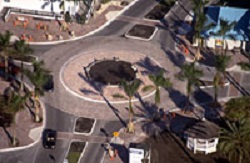Roundabout for Downtown Revitalization
Fort Pierce, Florida
Prepared by Laurie Actman, Patrick McMahon, Henry Renski, University of North Carolina Highway Safety Research Center, and Ramon Trias, City of Fort Pierce, FL.
Fort Pierce, Florida
Prepared by Laurie Actman, Patrick McMahon, Henry Renski, University of North Carolina Highway Safety Research Center, and Ramon Trias, City of Fort Pierce, FL.
High vehicle speeds, limited sight distances, and inadequate sidewalk facilities contributed to elevated pedestrian crash potential between Ft. Pierce's historic downtown and waterfront areas. The lack of sufficient pedestrian accommodations negatively impacted downtown businesses.
Fort Pierce is a seaside community located along the intercoastal waterway on the Atlantic Coast of Florida. By the early 1990s, the once-vibrant street life in downtown Fort Pierce had faded.
A major barrier to downtown revitalization was an inhospitable pedestrian environment, especially at the intersection of Avenue A and Indian River Drive, the gateway between the historic downtown and the waterfront area. Pedestrians found crossing the intersection difficult due to high vehicle speeds, blind corners, and inadequate sidewalk design.

The roundabout included splitter islands, colored crosswalks with median refuges in the splitter islands, curb extensions, curb ramps, and landscaping to slow motor vehicles and provide a safe and enjoyable pedestrian environment.
In the mid-1990s, private and public leaders decided to rebuild the community. A community charette, sponsored jointly by the City of Fort Pierce, the Main Street Fort Pierce program, and the Treasure Coast Regional Planning Council, was organized in January of 1995. A vision and plan for downtown reconstructing was developed at the meeting, and directives were adopted to make downtown more pedestrian friendly by slowing traffic, widening sidewalks, and providing more on-street parking.
Part of the plan included the construction of a roundabout at the intersection of Avenue A and Indian River Drive. Located on a Florida Department of Transportation road, the roundabout cost around $200,000 and was the first to be constructed according to new state guidelines for roundabouts. The completed roundabout is both beautiful and functional, built with stone details, palm trees, historic streetlights, and brick pavers, and designed to accommodate a large amount of intersecting vehicular and pedestrian traffic.
Curb extensions and median refuge islands were built on each approaching leg of the roundabout to make pedestrian crossing safer and easier. The crosswalks are clearly contrasted against the black pavement by light colored brick pavers.
Indian River Drive, which winds along the waterfront, was shifted inland slightly at its southern end to terminate at the roundabout. From the roundabout to the water, a large surface-level parking lot was partially converted into a circular extension of Avenue A. At its far end, Indian River Drive opens to a new waterfront park with wide brick sidewalks and curb extensions.
Before the project, vehicles often traveled through the area at 35 to 40 mi/h although the speed limit on Indian River Drive was 25 mi/h. The roundabout and curb extensions have been designed to keep speeds to a maximum of 10 mi/h as cars enter or leave the waterfront area, setting a leisurely pace for downtown driving.
The roundabout accommodates about 14,000 vehicles each day which is similar to the volume that passed through the traditional intersection before the project. At the same time, the pedestrian volume at the intersection has increased dramatically following the construction of the roundabout, from approximately 50 pedestrians per day to about 1,000 pedestrians per day. Slower vehicle speeds, complemented by the curb extensions and refuge islands, makes crossing the street safer for pedestrians and allows them to enjoy the downtown environment.
The roundabout included splitter islands, colored crosswalks with median refuges in the splitter islands, curb extensions, curb ramps, and landscaping, which helped re-energize the economic vitality of downtown Fort Pierce. The roundabout itself is considered a memorable landmark within the town, enhancing the entire downtown area. With the increase in pedestrian traffic, new restaurants, outdoor cafés and stores have opened in once vacant spaces. City officials and business representatives consider the project a huge success and consider the pedestrian-friendly design as the cornerstone of their effort to bring downtown back to life.
Ramon Trias, Director of Development
City of Fort Pierce
P.O. Box 1480
Fort Pierce, FL 34954
Phone: (772) 460-2200